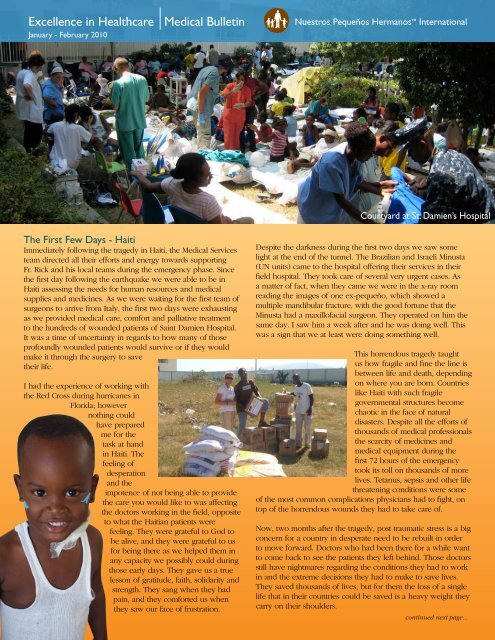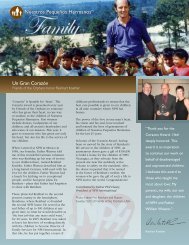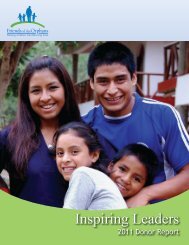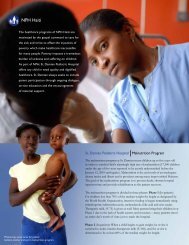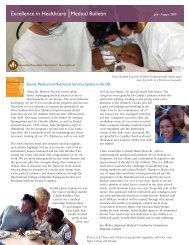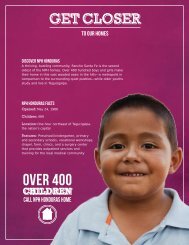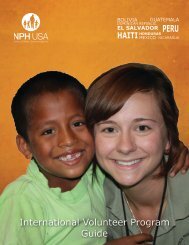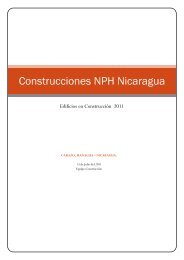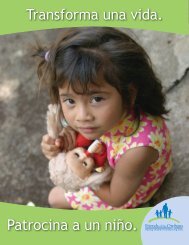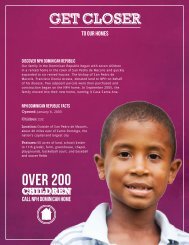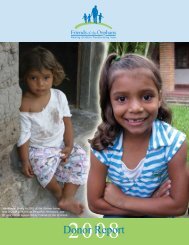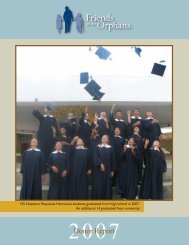Excellence in Healthcare Medical Bulletin - Friends of the Orphans
Excellence in Healthcare Medical Bulletin - Friends of the Orphans
Excellence in Healthcare Medical Bulletin - Friends of the Orphans
- No tags were found...
Create successful ePaper yourself
Turn your PDF publications into a flip-book with our unique Google optimized e-Paper software.
<strong>Excellence</strong> <strong>in</strong> <strong>Healthcare</strong> <strong>Medical</strong> Bullet<strong>in</strong>January - February 2010Nuestros Pequeños Hermanos InternationalCourtyard at St. Damien’s HospitalThe First Few Days - HaitiImmediately follow<strong>in</strong>g <strong>the</strong> tragedy <strong>in</strong> Haiti, <strong>the</strong> <strong>Medical</strong> Servicesteam directed all <strong>the</strong>ir efforts and energy towards support<strong>in</strong>gFr. Rick and his local teams dur<strong>in</strong>g <strong>the</strong> emergency phase. S<strong>in</strong>ce<strong>the</strong> first day follow<strong>in</strong>g <strong>the</strong> earthquake we were able to be <strong>in</strong>Haiti assess<strong>in</strong>g <strong>the</strong> needs for human resources and medicalsupplies and medic<strong>in</strong>es. As we were wait<strong>in</strong>g for <strong>the</strong> first team <strong>of</strong>surgeons to arrive from Italy, <strong>the</strong> first two days were exhaust<strong>in</strong>gas we provided medical care, comfort and palliative treatmentto <strong>the</strong> hundreds <strong>of</strong> wounded patients <strong>of</strong> Sa<strong>in</strong>t Damien Hospital.It was a time <strong>of</strong> uncerta<strong>in</strong>ty <strong>in</strong> regards to how many <strong>of</strong> thosepr<strong>of</strong>oundly wounded patients would survive or if <strong>the</strong>y wouldmake it through <strong>the</strong> surgery to save<strong>the</strong>ir life.I had <strong>the</strong> experience <strong>of</strong> work<strong>in</strong>g with<strong>the</strong> Red Cross dur<strong>in</strong>g hurricanes <strong>in</strong>Florida; howevernoth<strong>in</strong>g couldhave preparedme for <strong>the</strong>task at hand<strong>in</strong> Haiti. Thefeel<strong>in</strong>g <strong>of</strong>desperationand <strong>the</strong>impotence <strong>of</strong> not be<strong>in</strong>g able to provide<strong>the</strong> care you would like to was affect<strong>in</strong>g<strong>the</strong> doctors work<strong>in</strong>g <strong>in</strong> <strong>the</strong> field, oppositeto what <strong>the</strong> Haitian patients werefeel<strong>in</strong>g. They were grateful to God tobe alive, and <strong>the</strong>y were grateful to usfor be<strong>in</strong>g <strong>the</strong>re as we helped <strong>the</strong>m <strong>in</strong>any capacity we possibly could dur<strong>in</strong>gthose early days. They gave us a truelesson <strong>of</strong> gratitude, faith, solidarity andstrength. They sang when <strong>the</strong>y hadpa<strong>in</strong>, and <strong>the</strong>y comforted us when<strong>the</strong>y saw our face <strong>of</strong> frustration.Despite <strong>the</strong> darkness dur<strong>in</strong>g <strong>the</strong> first two days we saw somelight at <strong>the</strong> end <strong>of</strong> <strong>the</strong> tunnel. The Brazilian and Israeli M<strong>in</strong>usta(UN units) came to <strong>the</strong> hospital <strong>of</strong>fer<strong>in</strong>g <strong>the</strong>ir services <strong>in</strong> <strong>the</strong>irfield hospital. They took care <strong>of</strong> several very urgent cases. Asa matter <strong>of</strong> fact, when <strong>the</strong>y came we were <strong>in</strong> <strong>the</strong> x-ray roomread<strong>in</strong>g <strong>the</strong> images <strong>of</strong> one ex-pequeño, which showed amultiple mandibular fracture, with <strong>the</strong> good fortune that <strong>the</strong>M<strong>in</strong>usta had a maxill<strong>of</strong>acial surgeon. They operated on him <strong>the</strong>same day. I saw him a week after and he was do<strong>in</strong>g well. Thiswas a sign that we at least were do<strong>in</strong>g someth<strong>in</strong>g well.This horrendous tragedy taughtus how fragile and f<strong>in</strong>e <strong>the</strong> l<strong>in</strong>e isbetween life and death, depend<strong>in</strong>gon where you are born. Countrieslike Haiti with such fragilegovernmental structures becomechaotic <strong>in</strong> <strong>the</strong> face <strong>of</strong> naturaldisasters. Despite all <strong>the</strong> efforts <strong>of</strong>thousands <strong>of</strong> medical pr<strong>of</strong>essionals<strong>the</strong> scarcity <strong>of</strong> medic<strong>in</strong>es andmedical equipment dur<strong>in</strong>g <strong>the</strong>first 72 hours <strong>of</strong> <strong>the</strong> emergencytook its toll on thousands <strong>of</strong> morelives. Tetanus, sepsis and o<strong>the</strong>r lifethreaten<strong>in</strong>g conditions were some<strong>of</strong> <strong>the</strong> most common complications physicians had to fight, ontop <strong>of</strong> <strong>the</strong> horrendous wounds <strong>the</strong>y had to take care <strong>of</strong>.Now, two months after <strong>the</strong> tragedy, post traumatic stress is a bigconcern for a country <strong>in</strong> desperate need to be rebuilt <strong>in</strong> orderto move forward. Doctors who had been <strong>the</strong>re for a while wantto come back to see <strong>the</strong> patients <strong>the</strong>y left beh<strong>in</strong>d. Those doctorsstill have nightmares regard<strong>in</strong>g <strong>the</strong> conditions <strong>the</strong>y had to work<strong>in</strong> and <strong>the</strong> extreme decisions <strong>the</strong>y had to make to save lives.They saved thousands <strong>of</strong> lives, but for <strong>the</strong>m <strong>the</strong> loss <strong>of</strong> a s<strong>in</strong>glelife that <strong>in</strong> <strong>the</strong>ir countries could be saved is a heavy weight <strong>the</strong>ycarry on <strong>the</strong>ir shoulders.cont<strong>in</strong>ued next page...
The path to recovery for Haiti will be long and pa<strong>in</strong>ful. 20,000 young people, <strong>the</strong>future <strong>of</strong> Haiti, are now try<strong>in</strong>g to survive follow<strong>in</strong>g amputations or sp<strong>in</strong>al cord <strong>in</strong>juries.Thousands <strong>of</strong> children have been left orphaned. The need for cont<strong>in</strong>uous care for thispopulation is a big concern.Public health issues rema<strong>in</strong> a concern, and will be monitored for <strong>the</strong> com<strong>in</strong>g weekswhile people are still liv<strong>in</strong>g <strong>in</strong> temporary camps. Assurance <strong>of</strong> adequate sanitation willbe crucial <strong>in</strong> order to mitigate <strong>the</strong> risk <strong>of</strong> large-scale outbreaks <strong>of</strong> waterborne diseases.Food, safe water and shelter are <strong>the</strong> more urgent needs for Haitians to go back to alife as normal as possible.The NPHI <strong>Medical</strong> Service Team not only has been support<strong>in</strong>g Haiti <strong>in</strong> <strong>the</strong>field but also has been able to raise, thanks to <strong>the</strong> <strong>in</strong>credible support <strong>of</strong> Dom<strong>in</strong>icancorporations such Banco de Progreso and Fundacion Inicia, more than $120,000 <strong>in</strong>cash (5.5 million pesos) and more than $20,000 <strong>in</strong> <strong>in</strong>-k<strong>in</strong>d donations <strong>of</strong> water, foodand basic medic<strong>in</strong>es, which were vital <strong>the</strong> first days before donations from USAor Europe were able to make it to <strong>the</strong> DR and Haiti. Some members <strong>of</strong> <strong>the</strong> teamcont<strong>in</strong>ue to raise funds <strong>in</strong> <strong>the</strong>ir churches, through newspaper articles and televisionnews programs.S<strong>in</strong>ce <strong>the</strong> emergency phase is “<strong>of</strong>ficially over” <strong>the</strong> NPHI <strong>Medical</strong> Services team is backto its normal duties.Dr. Pilar Silverman, Executive Director <strong>of</strong> <strong>Medical</strong> ServicesTrust ObligesWhen look<strong>in</strong>g back on <strong>the</strong> previousweeks and <strong>the</strong> latest events <strong>in</strong> Haiti,my participation <strong>in</strong> it still seemssurreal. Thank God dur<strong>in</strong>g <strong>the</strong>emergency relief phase right after<strong>the</strong> earthquake hit Haiti we weretoo busy to stop and th<strong>in</strong>k aboutwhat we were fac<strong>in</strong>g. There still hasbeen no time to actually realize whathappened.I heard about <strong>the</strong> earthquake onJanuary 12th around 11pm throughan email that was sent by NPHIExecutive <strong>Medical</strong> Director Dr.Silverman right after her apartment<strong>in</strong> <strong>the</strong> neighbor<strong>in</strong>g Dom<strong>in</strong>ican Republic stopped shak<strong>in</strong>g. The message reached me<strong>in</strong> Austria where I happened to be for a short vacation. After a long night <strong>in</strong> front <strong>of</strong><strong>the</strong> TV while exchang<strong>in</strong>g emails seek<strong>in</strong>g out any news from Haiti with <strong>the</strong> worldwideNPH community, I headed back to Germany <strong>in</strong> order to get prepared for my journeyto Haiti.Jo<strong>in</strong>ed by German nurses Nunja Pilz and Heike Needham, I arrived <strong>in</strong> Haiti aboutone week after <strong>the</strong> quake. For three weeks we worked <strong>in</strong> different children and adultpost-op rooms <strong>of</strong> St. Damien. When Nunja and I started our first night shift a couple<strong>of</strong> hours after we had arrived we were assigned to a room with about 19 patients– children, adults, men and women, some <strong>of</strong> <strong>the</strong>m pregnant, all mixed up, lay<strong>in</strong>g on<strong>the</strong> floor, on mattresses and improvised cots, very few had a bed. The rooms werecrowded because every patient had a family member to care for <strong>the</strong>m day and night,as families didn’t want to leave <strong>the</strong>ir loved ones alone. Most families wouldn’t havehad a place to go anyway s<strong>in</strong>ce <strong>the</strong>ir homes no longer existed.Haiti Relief Efforts…without leav<strong>in</strong>g homeMany who spent time work<strong>in</strong>g <strong>in</strong> Haitidescribed be<strong>in</strong>g overwhelmed by <strong>the</strong> sights,sounds, sensations, and smells <strong>of</strong> <strong>the</strong> tragedy.I returned from a regularly scheduled visitto <strong>the</strong> NPH Mexico cl<strong>in</strong>ic two days before<strong>the</strong> earthquake <strong>in</strong> Haiti. Suddenly, <strong>in</strong>stead<strong>of</strong> writ<strong>in</strong>g updates on <strong>the</strong> chronically illchildren <strong>in</strong> Mexico, I found myself help<strong>in</strong>gto coord<strong>in</strong>ate <strong>the</strong> <strong>in</strong>ternational medicalvolunteer response at St. Damien’s. For me,<strong>the</strong> absence <strong>of</strong> those physical experienceswas perhaps <strong>the</strong> most surreal part <strong>of</strong>my efforts. I cont<strong>in</strong>ued to shuttle my sonback and forth to his pre-school, and tosee pediatric patients with colds and ear<strong>in</strong>fections at <strong>the</strong> <strong>in</strong>ner-city health center <strong>in</strong>Chicago, IL where I work three days a week.Before and after work, <strong>in</strong> <strong>the</strong> even<strong>in</strong>gs and onweekends, I was at my computer… “skyp<strong>in</strong>g”with people on <strong>the</strong> ground at St. Damien’s,discuss<strong>in</strong>g adult patients with sp<strong>in</strong>al cord<strong>in</strong>juries and seiz<strong>in</strong>g <strong>in</strong>fants with depressedskull fractures. I spoke by satellite phonewith <strong>the</strong> doctors at <strong>the</strong> University <strong>of</strong> Miamitent near <strong>the</strong> airport, I emailed with <strong>the</strong> head<strong>of</strong> <strong>the</strong> US emergency response team <strong>in</strong> <strong>the</strong>embassy at Port-au-Pr<strong>in</strong>ce, I helped arrange<strong>the</strong> evacuation <strong>of</strong> a couple <strong>of</strong> critically illpatients to <strong>the</strong> University <strong>of</strong> Michigan… and Ilooked for resources to send to <strong>the</strong> doctorsand staff car<strong>in</strong>g for patients with<strong>in</strong> Haiti.By a couple <strong>of</strong> days after <strong>the</strong> earthquake, itbecame clear that we needed to establisha system to deal with <strong>the</strong> outpour<strong>in</strong>g <strong>of</strong>support and desire to volunteer at ourhospital. At <strong>the</strong> request <strong>of</strong> NPHI staff andFa<strong>the</strong>r Rick, I worked with Vicky Medley <strong>of</strong><strong>Friends</strong> <strong>of</strong> <strong>the</strong> <strong>Orphans</strong> and Es<strong>the</strong>r Kemme<strong>of</strong> NPH Europe to establish a system forscreen<strong>in</strong>g and forward<strong>in</strong>g short term medicalvolunteer applications to NPHI <strong>Medical</strong> Teammembers work<strong>in</strong>g <strong>in</strong> <strong>the</strong> hospital <strong>in</strong> Haiti. Theoutpour<strong>in</strong>g <strong>of</strong> support quickly overwhelmed<strong>the</strong> <strong>in</strong>frastructure <strong>of</strong> St. Damien hospital, evenwith our small team stepp<strong>in</strong>g <strong>in</strong> to help…butwe are grateful to all who shared <strong>the</strong>ir time,energy, skills, supplies, and money…and alsoto those who tried to do so, but whose skillswe were not able to use!Now back to my regular responsibilities, I’llf<strong>in</strong>ish up those reports for Mexico…butrema<strong>in</strong> grateful that even without leav<strong>in</strong>g myhome, I could be a part <strong>of</strong> <strong>the</strong> phenomenaloutpour<strong>in</strong>g <strong>of</strong> support for our bro<strong>the</strong>rsand sisters <strong>in</strong> Haiti, and could connect withso many <strong>in</strong>credible and giv<strong>in</strong>g people whowere able to go and provide <strong>the</strong> care sobadly needed <strong>in</strong> <strong>the</strong> acute relief phase <strong>of</strong> ourresponse. Merci!Dr. Susan Haverkamp – Regional <strong>Medical</strong>Coord<strong>in</strong>ator Mexicocont<strong>in</strong>ued next page...
At least 17 <strong>of</strong> <strong>the</strong> 19 patients <strong>in</strong> our roomwere amputated and had lost at leastone limb. The <strong>in</strong>jured had pa<strong>in</strong> andfevers through <strong>the</strong> hot and humid nights<strong>of</strong> Port-au-Pr<strong>in</strong>ce. We hurried to f<strong>in</strong>dand distribute <strong>the</strong> medications, tried tokeep <strong>the</strong> IVs runn<strong>in</strong>g, and our patientsalive. After a few days, wounds became<strong>in</strong>fected, and some patients suffered fromtetanus <strong>in</strong>fections. Though we tried all wecould and treated <strong>the</strong>m with antibiotics,immunoglobul<strong>in</strong> and morph<strong>in</strong>e, not all <strong>of</strong><strong>the</strong>m made it.The unbelievable strength, hope and trust<strong>of</strong> our patients were what kept me go<strong>in</strong>g.Especially <strong>the</strong> children seemed to have nodoubt <strong>in</strong> us. Trust obliges. Many <strong>of</strong> <strong>the</strong> Haitian staff I have known for years, that suffered<strong>the</strong> loss <strong>of</strong> <strong>the</strong>ir homes and loved ones, trusted me. They expressed <strong>the</strong>ir feel<strong>in</strong>gs <strong>of</strong> be<strong>in</strong>goverwhelmed by some volunteers that had little <strong>in</strong>ternational experience, especially <strong>in</strong> <strong>the</strong>face <strong>of</strong> disaster. However, overall, <strong>the</strong> Haitians truly appreciated <strong>the</strong> <strong>in</strong>ternational volunteersthat came to support <strong>the</strong>m dur<strong>in</strong>g <strong>the</strong> disaster. I trusted my Haitian colleagues, mycolleagues <strong>of</strong> <strong>the</strong> NPHI <strong>Medical</strong> Services Team and all <strong>the</strong> former and current NPH/NPFSvolunteers that came down to help. We worked hard, calmly and efficiently. Their presencemade me feel so much more comfortable and secure. Thanks NPH family!ANNOUNCEMENT:Due to <strong>the</strong> Haiti earthquake<strong>the</strong> NPHI <strong>Medical</strong> Workshopwas postponed as <strong>the</strong> EDMSannounced via email to thosedirectly <strong>in</strong>volved. We are work<strong>in</strong>gto reschedule <strong>the</strong> workshop forSeptember 2010, depend<strong>in</strong>g on <strong>the</strong>availability <strong>of</strong> <strong>the</strong> guest experts.As soon as we receive <strong>the</strong>irconfirmation we will announce <strong>the</strong>date <strong>of</strong> <strong>the</strong> workshop.Jan Weber, Regional <strong>Medical</strong> Coord<strong>in</strong>ator Haiti & Dom<strong>in</strong>ican RepublicRight Place, Right Time and <strong>in</strong> <strong>the</strong> Right HandsDur<strong>in</strong>g <strong>the</strong> three weeks I spent <strong>in</strong> <strong>the</strong> St. Damien Hospitalpharmacy I assisted a team <strong>of</strong> Haitian pharmacists and technicians,and our German pharmacist, Dagny Henn<strong>in</strong>g who knows <strong>the</strong>pharmacy well after hav<strong>in</strong>g spent several months work<strong>in</strong>g <strong>the</strong>redur<strong>in</strong>g 2009.Medications and medical equipmen<strong>the</strong>lp to save lives, if <strong>the</strong> right product isavailable <strong>in</strong> <strong>the</strong> right place, at <strong>the</strong> righttime, and <strong>in</strong> <strong>the</strong> right hands, a goal thatwas not always easy to fulfill <strong>the</strong>se days<strong>in</strong> Haiti. Dur<strong>in</strong>g <strong>the</strong> earthquake manystorage racks <strong>in</strong> <strong>the</strong> pharmacy fell andmedications became mixed up and werenot classified by names or <strong>in</strong>dications <strong>in</strong><strong>the</strong> shelves anymore.Follow<strong>in</strong>g <strong>the</strong> earthquake, many adultssought care at St. Damien’s. Thehospital’s pharmacy generally only stocksmedications from <strong>the</strong> World Health Organization’s EssentialDrug List for Children. The adult care created challenges, as<strong>the</strong>ir conditions required treatments o<strong>the</strong>r than what is generallyavailable for <strong>the</strong> pediatric population <strong>of</strong> St. Damien. Fur<strong>the</strong>rmore,highly specialized health care pr<strong>of</strong>essionals arrived from around <strong>the</strong>world, who required specialized equipment and medications. Theoperat<strong>in</strong>g rooms immediately became orthopedic-focused, and amaternity ward that was created out <strong>of</strong> dire necessity. These arejust two examples <strong>of</strong> how <strong>the</strong> hospital quickly changed its usualfocus on pediatrics. As a consequence, not only <strong>the</strong> variety but also<strong>the</strong> quantity <strong>of</strong> <strong>the</strong> needed products, equipment and medicationsrose tremendously <strong>in</strong> a very short time.In order to meet <strong>the</strong> demands <strong>of</strong> <strong>the</strong> hospital, we receivedmany conta<strong>in</strong>ers <strong>of</strong> <strong>in</strong>-k<strong>in</strong>d donations that were provided fromdifferent <strong>in</strong>stitutions and organizations from all over <strong>the</strong> world.Incom<strong>in</strong>g donations were screened, checked for adequate quality(expiration dates, sterility, etc.) and stored<strong>in</strong> adequate quantities accord<strong>in</strong>g to <strong>the</strong>necessity and urgency <strong>of</strong> <strong>the</strong> products.Equipment and medications that werereceived <strong>in</strong> extremely large quantitieswere distributed appropriately to o<strong>the</strong>rhospitals and organizations <strong>in</strong> Haiti thatwere not as fortunate as we were toreceive such vital donations.The work <strong>in</strong> Haiti wasexhaust<strong>in</strong>g. However, I was given avery precious memory <strong>in</strong> <strong>the</strong>se days, amemory that I will always hold <strong>in</strong> myheart. It was a gift to see <strong>the</strong> smile <strong>of</strong> my Haitian colleagues thatkept <strong>the</strong>ir positive attitudes despite all <strong>the</strong> personal tragedies, likelosses <strong>of</strong> family members, friends, beloved ones, <strong>the</strong> loss <strong>of</strong> homesand belong<strong>in</strong>gs, <strong>the</strong> smiles <strong>of</strong> <strong>the</strong> many children, smil<strong>in</strong>g despite <strong>the</strong>fact that <strong>the</strong>y had lost <strong>the</strong>ir arms or legs.These smiles are a very good medic<strong>in</strong>e, too…N<strong>in</strong>a Ehrle, Regional <strong>Medical</strong> Coord<strong>in</strong>ator Guatemala & Nicaragua
Volunteer Coord<strong>in</strong>ationWhen people ask me “How wasHaiti?” <strong>the</strong> one word that comes tom<strong>in</strong>d is “overwhelm<strong>in</strong>g”.A few days after <strong>the</strong> earthquake Ibegan work<strong>in</strong>g with Monica Geryand Susan Haverkamp, as we tried t<strong>of</strong>igure out how our team could assist<strong>in</strong> <strong>the</strong> relief efforts at St. Damien.Just days later, I arrived <strong>in</strong> Haitiwith <strong>the</strong> task <strong>of</strong> coord<strong>in</strong>at<strong>in</strong>g <strong>the</strong>medical teams com<strong>in</strong>g to <strong>the</strong> hospital.Toge<strong>the</strong>r with Phadoul, <strong>the</strong> HumanResources manager, and <strong>the</strong> <strong>Medical</strong>Directors <strong>of</strong> St. Damien, Dr. Arty and Dr. Narcise, Fr. Rickand Conan, we decided where <strong>the</strong> volunteers could behelpful to fill <strong>in</strong> <strong>the</strong> gaps where local staff wasn’t available.I <strong>the</strong>n made assignments accord<strong>in</strong>gly for all <strong>of</strong> <strong>the</strong> help<strong>in</strong>ghands to cover day and night shifts <strong>in</strong> <strong>the</strong> hospital, and tostaff <strong>the</strong> mobile cl<strong>in</strong>ics that went out <strong>in</strong>to <strong>the</strong> city daily toprovide care to people that could not make it to <strong>the</strong> hospitalfor proper treatment. I was responsible for communicat<strong>in</strong>gour needs to Es<strong>the</strong>r Kemme, Susan Haverkamp and VickyMedley who were collect<strong>in</strong>g applications from medicalpersonnel <strong>in</strong>terested <strong>in</strong> go<strong>in</strong>g down. This was far from easy,as our needs were constantly chang<strong>in</strong>g.For about <strong>the</strong> first two weeks I was <strong>the</strong>re, we did <strong>the</strong> bestwe could with what little staff we had to work with. Ournurses were provid<strong>in</strong>g care for up to 20 patients at times,and work<strong>in</strong>g over 12-hour shifts. They were constantlyrunn<strong>in</strong>g from room to room, look<strong>in</strong>g for <strong>the</strong> neededmedications or supplies. They did all <strong>the</strong>y could to makesure <strong>the</strong>ir patients weren’t <strong>in</strong> pa<strong>in</strong>, that <strong>the</strong>y got <strong>the</strong>ir neededantibiotics on time, and that post-surgical patients weregett<strong>in</strong>g out <strong>of</strong> bed <strong>in</strong> order to prevent complications.Even though I myself wasn’t able to work <strong>in</strong> <strong>the</strong>role <strong>of</strong> a nurse due to <strong>the</strong> o<strong>the</strong>r responsibilitiesI had, I was so proud to see mycolleagues and fellow nurseswork<strong>in</strong>g so hard to br<strong>in</strong>g comfortto <strong>the</strong> patients and <strong>the</strong>ir families.I’m pretty sure not a s<strong>in</strong>gle one<strong>of</strong> us came away from Haitiwithout hav<strong>in</strong>g shed some tears<strong>of</strong> frustration and desperation, butat <strong>the</strong> same time I know that fromour experiences work<strong>in</strong>g with <strong>the</strong>people <strong>of</strong> Haiti we came awaymuch stronger people. Phadoul,who worked day and night, f<strong>in</strong>d<strong>in</strong>gtime to play <strong>in</strong> <strong>the</strong> courtyard to make<strong>the</strong> children smile, Dr. Arty com<strong>in</strong>g to care for <strong>the</strong> patientsdur<strong>in</strong>g her sabbatical year, <strong>the</strong> local staff work<strong>in</strong>g harddespite <strong>the</strong>ir personal situation, <strong>the</strong> <strong>in</strong>ternational volunteers,and <strong>the</strong> hope <strong>in</strong> <strong>the</strong> eyes <strong>of</strong> <strong>the</strong> patients and <strong>the</strong>ir families…it was <strong>in</strong>spir<strong>in</strong>g.Many <strong>of</strong> <strong>the</strong> volunteers that arrived were previous NPHvolunteers, not only from Haiti, but from <strong>the</strong> Dom<strong>in</strong>icanRepublic, Honduras, Mexico, Nicaragua and Peru. In <strong>the</strong>face <strong>of</strong> tragedy, family comes toge<strong>the</strong>r. I’ve never felt astronger sense <strong>of</strong> family with<strong>in</strong> NPH than I did while <strong>in</strong> Haiti.All <strong>of</strong> <strong>the</strong> support fromour donors, <strong>in</strong>ternational<strong>of</strong>fices, volunteers, andeven <strong>the</strong> children <strong>in</strong> <strong>the</strong>o<strong>the</strong>r NPH homes that wererais<strong>in</strong>g money to support<strong>the</strong>ir Haitian bro<strong>the</strong>rs andsisters…it was amaz<strong>in</strong>g.Annie Kautza, Regional<strong>Medical</strong> Coord<strong>in</strong>atorBolivia, El Salvador,Honduras, Peru
Updates from Our HomesMexicoDom<strong>in</strong>ican RepublicHaitiGuatemalaEl SalvadorHondurasBoliviaNicaraguaPeruBolivia:Childhood VisionProblemsThe majority <strong>of</strong> <strong>the</strong>common vision problemsthat can be correcteddepend on early detection,<strong>the</strong> acuteness <strong>of</strong> <strong>the</strong>problem and on <strong>the</strong> age <strong>of</strong><strong>the</strong> child. With prevention,serious problems <strong>in</strong> <strong>the</strong>future can be avoided. Aneye exam <strong>of</strong>fers an effectivemeans <strong>of</strong> reach<strong>in</strong>g <strong>the</strong>objective <strong>of</strong> detection and early correction.We are cont<strong>in</strong>u<strong>in</strong>g to perform <strong>the</strong> “well child checkups”,which <strong>in</strong>cludes a basic test <strong>of</strong> visual acuity, and as we havementioned previously this is a very useful tool to detectvisual problems early on. This will allow us to provide <strong>the</strong>child with <strong>the</strong> appropriate treatment, <strong>of</strong>fer<strong>in</strong>g our childrenquality health care. All <strong>of</strong> this is possible thanks to <strong>the</strong> help<strong>of</strong> all <strong>of</strong> <strong>the</strong> people that are always support<strong>in</strong>g and watch<strong>in</strong>gover <strong>the</strong> children <strong>of</strong> <strong>the</strong> NPH family.Dr. Ana Claudia Ayllon RiberaFamily Physician, NPH BoliviaWe recently detected some children with dim<strong>in</strong>ished visualacuity, and were able to take <strong>the</strong>m to <strong>the</strong> ophthalmologistto determ<strong>in</strong>e <strong>the</strong>ir exact diagnosis and to get <strong>the</strong>m <strong>the</strong>glasses <strong>the</strong>y required. Some children needed glasses for <strong>the</strong>first time, and o<strong>the</strong>rs just needed adjustments to <strong>the</strong> lenses<strong>the</strong>y already had.In our cl<strong>in</strong>ic we test visual acuity by us<strong>in</strong>g a Snellenchart. The chart presents <strong>the</strong> letter “E” po<strong>in</strong>t<strong>in</strong>g <strong>in</strong> variousdirections: with <strong>the</strong> l<strong>in</strong>es po<strong>in</strong>t<strong>in</strong>g down or up, to <strong>the</strong> leftor to <strong>the</strong> right, and <strong>the</strong> child shows us which direction <strong>the</strong>letter “E” is po<strong>in</strong>t<strong>in</strong>g.The signs that a child might be present<strong>in</strong>g visual difficultiesare not always obvious, but <strong>the</strong>y can <strong>in</strong>clude squ<strong>in</strong>t<strong>in</strong>gor clos<strong>in</strong>g one eye when <strong>the</strong>y read, excessive bl<strong>in</strong>k<strong>in</strong>g orrubb<strong>in</strong>g <strong>of</strong> <strong>the</strong> eyes, a cloudy appearance <strong>in</strong> <strong>the</strong> pupil <strong>of</strong><strong>the</strong> eye, or frequent headaches. Be<strong>in</strong>g attentive to signals<strong>of</strong> visual difficulties <strong>of</strong> <strong>the</strong> child may save <strong>the</strong> child frompresent and future problems.Vision problems, such as myopia or short-sightedness,hyperopia or farsightedness, astigmatism, and strabismus,if not treated with<strong>in</strong> an appropriate timeframe, may result<strong>in</strong> difficulties for <strong>the</strong> child. For example, it could lead tolearn<strong>in</strong>g difficulties if it is difficult or bo<strong>the</strong>rsome to read.The child may end up not want<strong>in</strong>g to read, and developnegative feel<strong>in</strong>gs towards <strong>the</strong> task.The child’s general activities may be affected as well, whichmay bo<strong>the</strong>r <strong>the</strong> child or make him or her feel sociallyrejected. For example, a child with uncorrected myopia thatplays basketball will have difficulties mov<strong>in</strong>g and shoot<strong>in</strong>gbaskets. This may end <strong>in</strong> <strong>the</strong> child not be<strong>in</strong>g well acceptedamong <strong>the</strong> o<strong>the</strong>r team members.Dom<strong>in</strong>ican Republic:Brenda’s Hope for a Kidney TransplantThe NPH family sticks toge<strong>the</strong>r and supports each o<strong>the</strong>racross all borders - especially <strong>in</strong> difficult situations. In <strong>the</strong>past two months NPH Dom<strong>in</strong>ican Republic was support<strong>in</strong>g<strong>the</strong> NPH family and <strong>the</strong> St. Damien hospital <strong>in</strong> Haiti on alllevels, by organiz<strong>in</strong>g equipment, medications, water andfood and by provid<strong>in</strong>g transport for both volunteers anddonations to Haiti.Besides all this enormous support for <strong>the</strong> neighbor<strong>in</strong>gcountry, NPH Dom<strong>in</strong>ican Republic also provided car<strong>in</strong>gsupport to Brenda from NPH Nicaragua, who had recentlymoved to <strong>the</strong> DR <strong>in</strong> <strong>the</strong> hope to receive a kidney transplant– a wish that was out <strong>of</strong> reach <strong>in</strong> her home countryNicaragua for lack <strong>of</strong> a national organ donor program.In Nicaragua, <strong>the</strong> second-poorest country <strong>in</strong> <strong>the</strong> Westernhemisphere after Haiti, resources are scarce and manyspecialized operations are not yet available.Hav<strong>in</strong>g spent <strong>the</strong> past three months <strong>in</strong> Casa St. Ana, Brendais already <strong>in</strong>tegrated <strong>in</strong> <strong>the</strong> home and <strong>in</strong> <strong>the</strong> girls’ section‘San Esteban’ (see above picture).cont<strong>in</strong>ued next page...
She receives hemodialysis three times a week <strong>in</strong> <strong>the</strong>hospital <strong>in</strong> San Pedro de Macorís, only ten m<strong>in</strong>utes awayfrom <strong>the</strong> home. The shunt <strong>in</strong> her left arm has now beenfunction<strong>in</strong>g successfully for about one month, and thus <strong>the</strong>ca<strong>the</strong>ter <strong>in</strong> her neck was able to be removed. The use <strong>of</strong><strong>the</strong> new shunt and <strong>the</strong> removal <strong>of</strong> <strong>the</strong> ca<strong>the</strong>ter do not onlydelight Brenda for aes<strong>the</strong>tic reasons, but also improvesBrenda’s health care as her risk <strong>of</strong> acquir<strong>in</strong>g <strong>in</strong>fections issignificantly reduced now.We hope that Brenda will be on <strong>the</strong> national wait<strong>in</strong>g listfor transplant with<strong>in</strong> <strong>the</strong> next weeks and pray that she willsoon receive a donor kidney.N<strong>in</strong>a Ehrle, RMC Nicaragua and Guatemala & Jan Weber:RMC Dom<strong>in</strong>ican Republic and HaitiMexico: ClínicaBuen SamaritanoThe new year broughtmany changes to<strong>the</strong> medical cl<strong>in</strong>ic atNPH Mexico. First,<strong>the</strong> cl<strong>in</strong>ic celebratednews that mov<strong>in</strong>g <strong>the</strong>pharmacy out <strong>of</strong> <strong>the</strong>area where <strong>the</strong> nursestriage patients to asecure and dedicated area allowed us to pass our end<strong>of</strong>-year<strong>in</strong>ventory control audit with fly<strong>in</strong>g colors for<strong>the</strong> first time ever. Congratulations to volunteer Cl<strong>in</strong>icAssistant Dan Peck and nurse/Local Health Coord<strong>in</strong>atorFrancisca Palacios for <strong>the</strong>ir hard work and success <strong>in</strong> thisreorganization <strong>of</strong> <strong>the</strong> pharmacy.Second, <strong>in</strong> early February <strong>the</strong> cl<strong>in</strong>ic celebrated <strong>the</strong> arrival<strong>of</strong> volunteer physical <strong>the</strong>rapist Jeremy Sullivan. Jeremycomes to NPH from <strong>the</strong> Rehabilitation Institute <strong>of</strong> Chicago.Jeremy worked with <strong>the</strong> NPH Mexico projects coord<strong>in</strong>atorto purchase equipment for <strong>the</strong> <strong>the</strong>rapy room with <strong>the</strong>support <strong>of</strong> a generous donation, and <strong>in</strong> a very short period<strong>of</strong> time has ga<strong>in</strong>ed <strong>the</strong> trust and acceptance <strong>of</strong> some <strong>of</strong><strong>the</strong> cl<strong>in</strong>ic patients with chronic orthopedic needs. Wewelcome Jeremy, and are thrilled with <strong>the</strong> new service andequipment that we can <strong>of</strong>fer to <strong>the</strong> patients at NPH Mexico.And lastly, at <strong>of</strong> <strong>the</strong> end <strong>of</strong> February, former pequeño Dr.Alejandro Zacarias has departed after five years as <strong>the</strong>leader <strong>of</strong> <strong>the</strong> medical department <strong>in</strong> Mexico. Dr. Zacariaswill be pursu<strong>in</strong>g specialty tra<strong>in</strong><strong>in</strong>g <strong>in</strong> Family Medic<strong>in</strong>e.Wethank him for his efforts and wish him well <strong>in</strong> his fur<strong>the</strong>rpursuits.We will look forward to <strong>in</strong>troduc<strong>in</strong>g our new leadphysician <strong>in</strong> a future newsletter!Dr. Susan Haverkamp, Regional <strong>Medical</strong> Coord<strong>in</strong>atorMexicoHaiti: Dlo Pwóp – Clean WaterOne aspect <strong>of</strong> <strong>the</strong> efforts made to establish a state <strong>of</strong>normalcy is to get back to challenges that we have beenfac<strong>in</strong>g even before <strong>the</strong> earthquake <strong>of</strong> January 12th. One<strong>of</strong> <strong>the</strong>se cont<strong>in</strong>u<strong>in</strong>g challenges was <strong>the</strong> potable watersituation at NPFS Haiti. More than three years ago <strong>the</strong>partner<strong>in</strong>g NGO International Action (www.haitiwater.org)provided us five free water filters – easy to recognize by<strong>the</strong>ir happily colored flags – and respective ma<strong>in</strong>tenanceservice on a regular basis. Therefore <strong>the</strong> potable watersupply had been stable and secure. The challenge<strong>in</strong>volved was that our children still had to pick up <strong>the</strong>potable water at <strong>the</strong> assigned taps <strong>in</strong> order to carry it to<strong>the</strong>ir houses, which is no easy task given <strong>the</strong> fact that <strong>the</strong>children’s houses are spread all over hilly property.In a co-operational effort <strong>of</strong> International Action andNPFS Haiti a new agreement was made to supply all 19houses with water filters. International Action is <strong>in</strong>stall<strong>in</strong>g<strong>the</strong> filters while us<strong>in</strong>g material out <strong>of</strong> <strong>the</strong>ir stock and willcont<strong>in</strong>ue to provide free service and ma<strong>in</strong>tenance <strong>in</strong> <strong>the</strong>future whereas NPFS only needs to add $640 to purchasesome miss<strong>in</strong>g materials.A respective <strong>in</strong>tranet project was posted and will hopefullybe considered soon. On March 12th <strong>the</strong> InternationalAction eng<strong>in</strong>eers, led by Dalebrun Es<strong>the</strong>r and jo<strong>in</strong>ed by<strong>the</strong>ir visit<strong>in</strong>g International Director, visited <strong>the</strong> orphanageand <strong>the</strong> first four houses were equipped with filters. Thekids are enjoy<strong>in</strong>g <strong>the</strong>ir direct access to <strong>the</strong> now potableand safe water. The children <strong>of</strong> NPFS Haiti say MERCIBEAUCOUP to International Action for <strong>the</strong>ir generosity,<strong>the</strong> excellent cooperation and <strong>the</strong>ir reliable service!Jan Weber, Regional <strong>Medical</strong> Coord<strong>in</strong>ator Haiti &Dom<strong>in</strong>ican RepublicNPHI <strong>Excellence</strong> <strong>in</strong> <strong>Healthcare</strong>For more <strong>in</strong>formation contact:Annie Kautza at: akautza@nph.orgDesign by: Monica Gery, NPHI Information Officer


